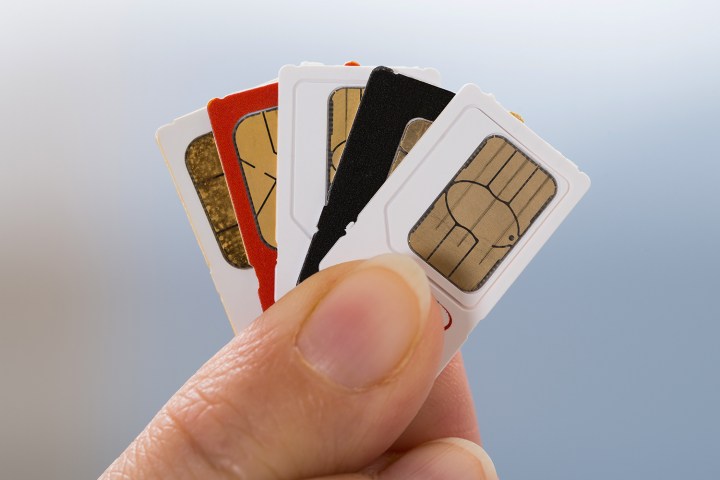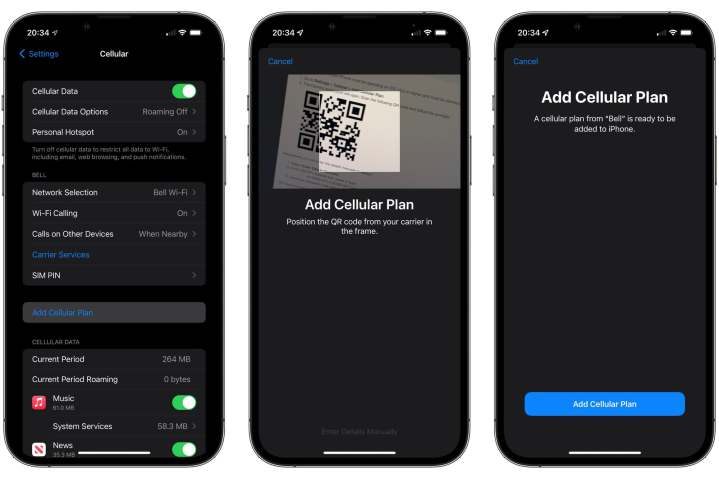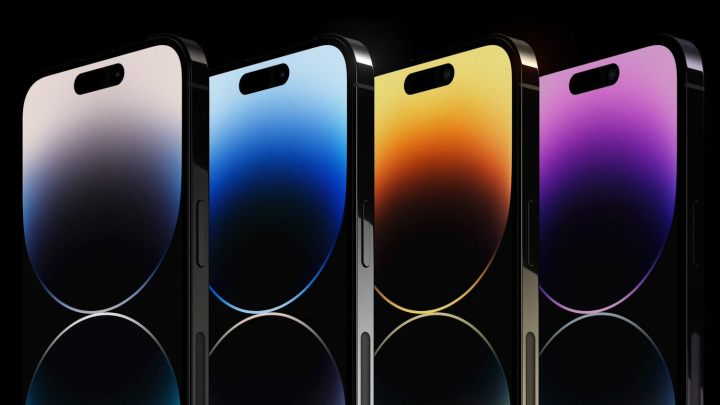The humble SIM card has survived for quite a while, but it’s no longer used in modern, premium phones. Instead, manufacturers incorporate embedded SIMs, or eSIMs, to identify your device to carriers. Pay-as-you-go services like Straight Talk still use tried-and-true SIM cards, but it’s becoming increasingly common to find your phone now comes with an eSIM rather than a physical SIM card.
But what is an eSIM? Here, we explain what an eSIM is and how it’s different from a removable SIM card.
What is a SIM card?
This is the more familiar solution of the two. It’s a Subscriber Identity Module that sits in a special tray and slides into a device like a drawer. It’s typically supplied by a carrier and programmed with account information, like your phone number and security keys, to identify and authenticate you on your carrier’s network. SIM cards can also store contacts and SMS messages, although these features are rarely used as today’s smartphones are much more powerful.
Without this card, your phone doesn’t even have a valid phone number, so you won’t be able to make or receive calls on a wireless network. The U.S. and many other countries require that phones are able to place calls to emergency services, even without a SIM card — but that’s an exception.

This small card has a notch on one corner with gold circuits on one side that connect to a card reader inside your phone. SIM cards come in four different sizes — standard, mini, micro, and nano — so you need to ensure you get the correct size for the phone you’re using.
Most significantly, since a SIM card is removable, you can easily remove it from one device and insert it into another. This allows you to upgrade your phone without calling your carrier. It’s also a great way to avoid roaming charges when traveling by setting up a pay-as-you-go service with a local carrier at your destination; swap out your regular SIM card, pop in a card from a local carrier, and you’ll have a new phone number on their network. You can often pick up prepaid SIM cards at airport kiosks and be up and running with a local number minutes after you land.
What is an eSIM?
An embedded SIM, or eSIM, cannot be removed. It’s a programmable SIM card that’s physically connected (soldered) to your smartphone’s motherboard. It does everything a removable SIM card does, but you can’t physically remove it — at least not without breaking open the phone and unsoldering the chip.
This may seem problematic at first glance. For instance, when traveling abroad using phones with removable SIM cards, you can swap to another carrier’s SIM card to get local coverage and avoid paying roaming fees from your primary carrier. Likewise, if you want to switch local carriers but keep your phone, a removable SIM card can be popped out and easily replaced with a new one in seconds. Your first impression may be that this is impossible with an eSIM.
However, eSIM technology actually makes switching carriers even easier, at least in theory. Instead of waiting for a new SIM card to ship or making a trip to a local store to pick one up, you can make the switch right on your phone by entering information from your carrier — often just by scanning a QR code with your smartphone’s camera. If your smartphone has an eSIM inside, you’ll find options in the settings that allow you to configure your eSIM, switch between lines and carriers, and manage your accounts. If you’re a dual-SIM user, eSIM technology may even support multiple accounts — and switching between them is super easy.

Unfortunately, while getting an eSIM should be easier than obtaining a physical SIM, that’s not always the case. Some carriers have taken longer than others to embrace the seamlessness of eSIM, and it’s not uncommon to encounter a few that still want to mail you your eSIM codes or have you visit a store before you can set up your phone. That takes away one of the biggest advantages of using an eSIM, but thankfully most carriers are working quickly to catch up with the times.
The other significant benefit of eSIM technology is the space saved by removing a physical SIM tray. Devices can be smaller because the eSIM chip is embedded on the device’s motherboard — there’s no unnecessary space taken up by placing a slot and tray on the outside edge of the device. This allows for thinner designs and larger batteries.
Devices with eSIM technology
Google’s Pixel 2 shipped with an eSIM that only supported Google Fi, whereas the Pixel 3 and newer Pixel devices support third-party mobile carriers. Samsung brought eSIM to its flagship smartphone lineup with the Galaxy S20, and Microsoft’s Surface Pro LTE was the first Windows 10 device to ship with eSIM technology.
Apple introduced eSIM in 2017 with the Apple Watch Series 3, the first LTE-capable Apple Watch. While the Apple Watch uses eSIM exclusively, when the iPhone XS and iPhone XR debuted the following year, Apple added eSIM to complement the physical SIM card slot and offer support for two phone lines. Apple also added eSIM to the 2018 iPad Pro, although it didn’t remove the physical SIM card slot; eSIM was offered as an alternative for those who preferred to use that to set their iPad up for cellular service instead of a physical SIM.
Apple continues to use a combination of a physical SIM card and eSIM in nearly all iPhone models. However, last year, the iPhone 13 gained support for using two eSIM cards, letting users get dual-SIM support without the need for a physical SIM card. That paved the way for this year’s iPhone 14 lineup, where Apple has now removed the physical SIM card slot entirely on U.S. models, making eSIM the only way to get your iPhone 14 activated on a carrier network.

iPhone 14 models sold in most other countries still include two eSIM cards and one physical SIM card slot, the same as the iPhone 13. The notable exception to this rule is China, where eSIM has never been included on an iPhone. Instead, when Apple debuted the iPhone XS/XR in China, it provided two physical SIM card slots. That practice has continued to this day, even with the iPhone 14 lineup, which still sports two physical SIM slots in China — and no eSIM at all.
However, if you’re in the U.S. and want a physical SIM card slot on your iPhone 14, there’s one thing you’ll want to keep in mind before hopping up to Canada or down to Mexico to do a little cross-border shopping. Although all North American iPhone models support the same 4G/LTE, low-band 5G, and mid-band 5G frequencies, only the U.S. iPhone models support the mmWave 5G used for the fastest portions of Verizon’s 5G Ultra Wideband and AT&T’s 5G Plus coverage.
When can I start using an eSIM?
Chances are, your mobile device already has an eSIM card, as we’ve outlined above. Laptops with cellular connectivity mostly connect using eSIM technology, like the Surface Pro X and various models from Acer, Asus, Dell, HP, Lenovo, and Samsung. You will still see cases where SIM cards are employed in laptop designs, but that’s becoming far less common.
Until eSIM tech becomes the universal standard, many phones will still have a tray designated for a removable SIM card. There’s nothing wrong with using one of these phones — it’s just an older means to identify you on a carrier’s network. Still, swapping out a SIM card can be troublesome, given its size and delicate do-not-touch circuits. Managing an eSIM is easier for everyone, whether you’re switching phones or moving to another carrier.
If you’re using a dual-SIM phone with both a physical SIM card and eSIM, such as an iPhone or Google Pixel, you may also be able to transfer your physical SIM information directly to your eSIM. Many carriers allow for this, and iOS and Android provide tools to make it quick and easy. Once that’s done, you can toss your old SIM card aside and free up that slot for a physical SIM card for traveling.
Nevertheless, while you’ll want to check ahead, you may be pleasantly surprised to find how many international carriers support eSIM, and it’s hard to argue that it’s much easier to scan a QR code than trying to fiddle with swapping out a small and fragile SIM card, especially when traveling through a busy airport.
Editors’ Recommendations




